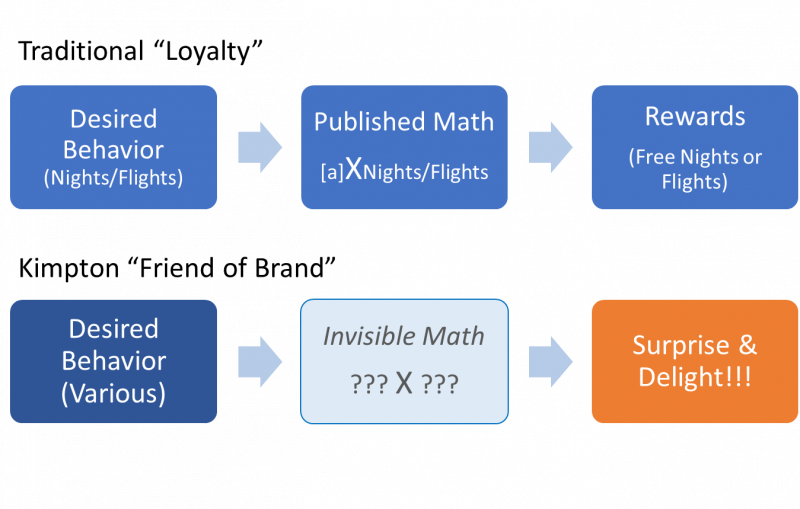How Kimpton Hotels is using ‘karma credits’ to drive loyalty
Airline loyalty programmes are often transactional but surprising and delighting guests might be more effective, as Tom Bacon discovered at a recent EyeforTravel show
As airlines revamp their loyalty programmes, typically replacing mileage-based credits with dollar-based credits, potentially they are missing the mark. Airline loyalty programmes remain highly transactional – with arithmetically derived earnings and rewards. Whether a passenger earns a free trip based on five round-trips or $15,000 in spend, doesn’t change the basic mathematics: more flying drives more free trips. In some sense, loyalty programmes are essentially a volume discount.
At least one hospitality company, Kimpton Hotels, has another approach, as emerged at a recent EyeforTravel conference. Kimpton has a supplemental credit system, ‘karma credits’, that remains unknown to the passenger! Customers don’t know exactly how to earn karma credits; the arithmetic is invisible. Thus, customers don’t view the system as transactional. Instead, customers who build up such credits are termed ‘friends of the brand’, rather than the more arithmetically based ‘frequent flyers’.
Customers who earn hidden credits gain extra attention, which frontline employees can then tap into as part of any one-on-one interaction
The system is designed explicitly around ‘delight and surprise’. Customers who earn hidden credits gain extra attention, which frontline employees can then tap into as part of any one-on-one interaction; rewards are cashed by hotel check-in personnel, for example, to make the experience better. Rather than explicitly or mathematically quid-pro-quo, the benefits are handed out ‘for free’. And, the cycle becomes virtuous, as the customer offers positive reviews or endorsements or social media shares, which may also drive more invisible points. The ‘Friends of the Brand’ programme replaces entitlement with surprise and delight.

Five benefits
Besides adding to customer satisfaction, the programme has the following benefits versus transactional loyalty:
-
The ‘earning’ algorithm can be variable. Airlines currently offer special mileage programmes – double miles on new flights, for example. But a non-transparent programme can be even more discrete – offering more credits in more competitive markets, more for certain flights, or more for higher volume – all introduced, modified, and taken out again without fanfare.
-
‘Earning’ can be personalised. Greater personalisation is a stated goal of many travel merchandisers. With non-transparent credits, different passengers or market segments can get different amounts of credits for desired activities.
-
‘Earning’ can focus on different behaviours than standard loyalty programmes. Kimpton’s programme adds up social media sharing and other endorsements – behaviours besides hotel night stays. Any such non-transparent programme could alternatively add up meal spend, it could reward booking directly on the website, it could value staying on a weekend, it could include flight activity/spend – or not.
-
Similarly, a non-transparent programme can vary in Rewards, by person, place, and behaviour. Wouldn’t different people value lounge access more or less? Lounge access, also, can be more generous at off-peak times or locations.
-
A non-transparent program can leverage one-on-one interactions. A huge advantage of the non-transparent programme is that it can be delivered by a front line employee – ‘here’s a free upgrade,’ or ‘here’s a meal voucher,’ or, for an airline, ‘hey, the whole row ahead of you is empty, let me move you’. In the new world of ancillary, frontline employees (for airlines, this includes airport agents and flight attendants) are often restricted from ‘giving anything away’ and a premium is placed on ‘selling’. To give the front line the ability to ‘surprise and delight’ is a win-win for an airline, driving greater satisfaction among both travellers and employees.
Paradoxically, such a programme can be even more mathematical, ‘optimised’ versus mileage programmes. The programme can be highly dynamic, changing both the ‘earning’ and the ‘rewards’ algorithms to drive the desired results.
Perhaps, Kimpton’s approach – offering both a standard frequent traveller programme along with a non-transparent ‘friend of the brand’ programme – is the ideal. In any case, however, airlines and other travel merchandisers should consider the benefits of ‘surprise and delight’ as an objective, rather than relying completely on a wholly transactional loyalty programme.
Tom Bacon has been in the business for 25 years, as an airline veteran and now industry consultant in revenue optimisation. He leads audit teams for airline commercial activities including revenue management, scheduling and fleet planning.
Email Tom at or visit his website

